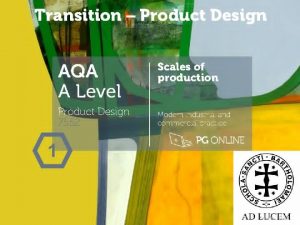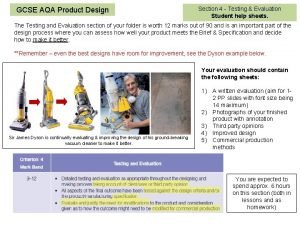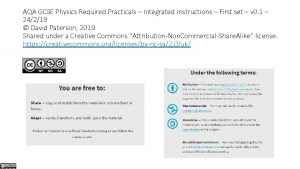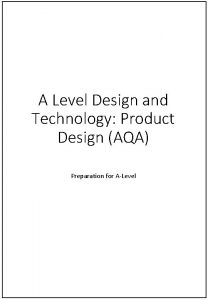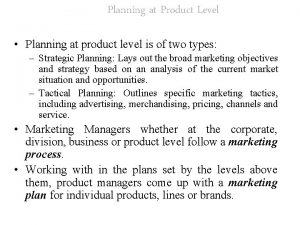Transition Product Design AQA A Level Product Design






























- Slides: 30

Transition – Product Design AQA A Level Product Design 7552 1 Scales of production Modern industrial and commercial practice

Video Links Video links – Britain's greatest furniture maker at work at his world-famous workshop How It's Made - Plastic Molded Kayak Link Video Lego production Nissan Juke Production "It's about Time ! This is QRM !" Smart. MRT Unit Production Hanger System (Apparels)

Objectives • Describe the characteristics of different scales of production including unit production systems, quick response manufacturing and vertical in-house production • Understand the value of different scales of production to the manufacturer and the consumer

Scales of production Unit 10 Modern industrial and commercial practice Starter • What do you think might be the level of demand for each knife?

Scales of production Unit 10 Modern industrial and commercial practice Scales of production • Scale refers to ‘size’ or ‘level’, which depends on the: • Type of product • Demand (long and short term) • Unit cost • Set-up costs • Research the term 'economy of scale'

Scales of production Unit 10 Modern industrial and commercial practice A need for products • For millennia humans have been making products to make their lives easier • Clothing, tools and dwellings are some of the earliest artefacts • Products were made to trade for food and other products • Professions were established and skills were handed down the generations • As demand increased, production methods changed

Scales of production Unit 10 Modern industrial and commercial practice Increasing production levels • Achieving consistency and quality across multiple products became challenging • Think how did makers and crafts people improve accuracy and speed up their production processes to meet demand?

Scales of production Unit 10 Modern industrial and commercial practice Historical context • As far back as 500 BC the Chinese were using division of labour and mass production methods • They produced: • Agricultural tools • China and terracotta products • Weapons • The development of which manufacturing method greatly contributed to this?

Scales of production Unit 10 Modern industrial and commercial practice Industrial revolution • Industrial revolution, circa 1760, saw an increase in automation • Linear assembly processing began in many areas including: • Ship building • Bridge construction • Tower building • Locomotive manufacture • Which key invention drove the industrial revolution?

Scales of production Unit 10 Modern industrial and commercial practice Production lines • In the early 1900 s Oldsmobile and Ford introduced production lines to their factories • This coincided with the standardisation of components and parts • Why is standardisation important? • Which major event of the early 20 th century accelerated the development of mass production and why?

Scales of production Unit 10 Modern industrial and commercial practice Bespoke or one-off • Bespoke, one-off or ‘made to measure’ products are: • ‘Tailor made’ to specific user needs • Made by highly skilled people • Made predominantly ‘by hand’ • Of high-quality using quality materials • Time consuming to produce • Think why do people pay extra for one-off products?

Scales of production Unit 10 Modern industrial and commercial practice One-off products • A bespoke product is often seen as an investment as each product is unique • These products can include: • • Suits and dresses Artwork, ceramics and jewellery Architecture Furniture • Does a set of six chairs for a client count as one-off production?

Scales of production Unit 10 Modern industrial and commercial practice A one-off profile • A business producing bespoke products often has the following characteristics: • A small company or crafts person with a limited number of staff • Close communication with the client • High-quality materials are used • Highly skilled labour is required for handcrafted elements • Unique and high-quality products are produced in low volumes • High unit cost

Scales of production Unit 10 Modern industrial and commercial practice Batch production • Batch production is used when a greater number of products are required • From more than one, to thousands of units • Use of jigs, moulds, formers and templates for accuracy, consistency and efficiency • CAD/CAM may be used • Why are some batch produced items referred to as 'hand-finished'?

Scales of production Unit 10 Modern industrial and commercial practice Batch produced goods • Batch production is suited to seasonal products with limited demand • Types of products include: • Printed items such as newspapers, magazines and books • Most clothing • Perishable food products • Seasonal goods • Why are many items of sports equipment batch produced?

Scales of production Unit 10 Modern industrial and commercial practice Batch production profile • Businesses that batch produce products often have the following characteristics: • A simple production line • Some level of automation • Skilled and semi-skilled workers • Flexibility to adapt their product line • Produce limited product runs • Lower unit costs

Scales of production Unit 10 Modern industrial and commercial practice Mass or line production • Mass or line production is used when a high number of products need to be produced quickly and consistently • Uses a production/assembly line • High-level of automation • High initial set-up costs • What roles might skilled workers play in automated production?

Scales of production Unit 10 Modern industrial and commercial practice Mass produced goods • Mass production requires very high capital investment • It is suited to high and continuous products runs including: • Packaging and containers such as boxes, bottles and cans • Many food products • Materials, such as steel and timber stock • Paper stock and paper products • Why might some mass produced items be made in batches?

Scales of production Unit 10 Modern industrial and commercial practice Mass production profile • Businesses mass producing products often have the following characteristics: • High set-up costs and capital investment • Shift work is used to facilitate 24/7 production • Both skilled and unskilled labour required • Expensive purpose made tooling and machinery required • High-level of automation • Low unit cost • Less flexibility for product diversity and slow to respond to change

Scales of production Unit 10 Modern industrial and commercial practice Scales of production • Complete Task 1 of Worksheet 1

Scales of production Unit 10 Modern industrial and commercial practice Efficient production methods • Manufacturers often seek to implement increasingly more efficient systems • This can be in response to market 'pull' or demand • It is often to gain a competitive advantage through: • A reduction in lead time meaning their products are the first to market • The need to cut costs, meaning that they can undercut the competition • What is meant by the term Kaizen?

Scales of production Unit 10 Modern industrial and commercial practice Lean production • Lean manufacturing strives to reduce waste and stems from a Japanese philosophy originating at Toyota • There are seven distinct areas for waste reduction: • Overproduction • Waiting • Transportation • Over processing • Excessive inventory • Unnecessary motion • Defects

Scales of production Unit 10 Modern industrial and commercial practice Unit production systems (UPS) • UPS use overhead tracks to move component parts, usually garments, on hanging carriers • Workers at each station perform a specific task before returning the product to the carrier and to be sent to the next workstation • A UPS offers increased control of workflow • Streamlines assembly and speeds up production • Automatic movement of products reduces labour costs • Stages of production are logged, improving quality control • What other advantages does this system offer?

Scales of production Unit 10 Modern industrial and commercial practice Quick response manufacturing • QRM reduces lead times in response to demand • Production is triggered by consumer demand not through traditional methods such as trend forecasting • Time-based competition (TBC) is a strategy used to get ahead of the competition and is a feature of QRM

Scales of production Unit 10 Modern industrial and commercial practice QRM profile • Reduced time to market through: • A reduction in external and internal lead times by improving communication and systems • The ability to respond more efficiently to customer pull, market demand fluctuations in fashion • Increasing flexibility in the manufacturing process using ‘flow’ production methods • Increasing the amount of ‘added value’ • Why is team work so important?

Scales of production Unit 10 Modern industrial and commercial practice Vertical production • Vertical ‘in house’ production increases productivity and profits by integrating parts of the supply chain within the main company • This frequently involves the acquisition of other companies responsible for the supply of raw materials, delivery and retail

Scales of production Unit 10 Modern industrial and commercial practice Need a reliable supply chain? • Vertical in house production is a way to ensure a robust and reliable supply chain • Advantages of owning the supply chain are: • Fixed prices for parts and services • A reliable source and supply of parts and services • Transparent and shared quality assurance procedures • Disadvantages include: • Diversification of core business, potential lack of skills • Greater administration and complex management structure • Very high capital outlay

Scales of production Unit 10 Modern industrial and commercial practice Case study • Microsoft has bought out over 200 companies and has stakes in many more • Most of these are digitally based and add strength to the Microsoft brand portfolio • Company acquisitions also reduce potential competition • Latest additions include Cloud management, 3 D gaming and Artificial Intelligence companies • Give examples of other companies that use this strategy

Scales of production Unit 10 Modern industrial and commercial practice Plenary • Complete Task 2 and 3 of the worksheet

Scales of production Unit 10 Modern industrial and commercial practice Copyright © 2018 PG Online Limited The contents of this unit are protected by copyright. This unit and all the worksheets, Power. Point presentations, teaching guides and other associated files distributed with it are supplied to you by PG Online Limited under licence and may be used and copied by you only in accordance with the terms of the licence. Except as expressly permitted by the licence, no part of the materials distributed with this unit may be used, reproduced, stored in a retrieval system, or transmitted, in any form or by any means, electronic or otherwise, without the prior written permission of PG Online Limited. Licence agreement This is a legal agreement between you, the end user, and PG Online Limited. This unit and all the worksheets, Power. Point presentations, teaching guides and other associated files distributed with it is licensed, not sold, to you by PG Online Limited for use under the terms of the licence. The materials distributed with this unit may be freely copied and used by members of a single institution on a single site only. You are not permitted to share in any way any of the materials or part of the materials with any third party, including users on another site or individuals who are members of a separate institution. You acknowledge that the materials must remain with you, the licencing institution, and no part of the materials may be transferred to another institution. You also agree not to procure, authorise, encourage, facilitate or enable any third party to reproduce these materials in whole or in part without the prior permission of PG Online Limited.
 Aqa a level biology transition guide answers
Aqa a level biology transition guide answers Aqa a level art and design
Aqa a level art and design Art and design a level aqa
Art and design a level aqa Art and design a level aqa
Art and design a level aqa Aqa product design
Aqa product design Aqa product design specification
Aqa product design specification Countercurrent exchange in fish
Countercurrent exchange in fish Steven berkoff fact file
Steven berkoff fact file Physics required practicals
Physics required practicals Relationships a level psychology
Relationships a level psychology Memory psychology a level
Memory psychology a level Attachment types psychology a level
Attachment types psychology a level Aqa a level physics data sheet
Aqa a level physics data sheet Aqa a level english literature b past papers
Aqa a level english literature b past papers Aqa rs 2020 paper
Aqa rs 2020 paper Aqa a level chemistry paper 1 2020
Aqa a level chemistry paper 1 2020 Aqa a level history tudors example answers
Aqa a level history tudors example answers Aqa design and technology past papers
Aqa design and technology past papers Transition level
Transition level Transition altitude vs level
Transition altitude vs level Wjec eduqas design and technology
Wjec eduqas design and technology Gcse food tech nea 2 example
Gcse food tech nea 2 example Digital illuminate aqa food preparation and nutrition
Digital illuminate aqa food preparation and nutrition Religious beliefs about helping victims of war
Religious beliefs about helping victims of war Ratio higher gcse questions
Ratio higher gcse questions Aqa english language paper 1
Aqa english language paper 1 Gcse pe 9 mark question examples
Gcse pe 9 mark question examples Gcse geography manchester case study
Gcse geography manchester case study Gcse geography edexcel b revision checklist
Gcse geography edexcel b revision checklist Kendal industrial park aqa
Kendal industrial park aqa Aqa eng lang paper 2
Aqa eng lang paper 2




